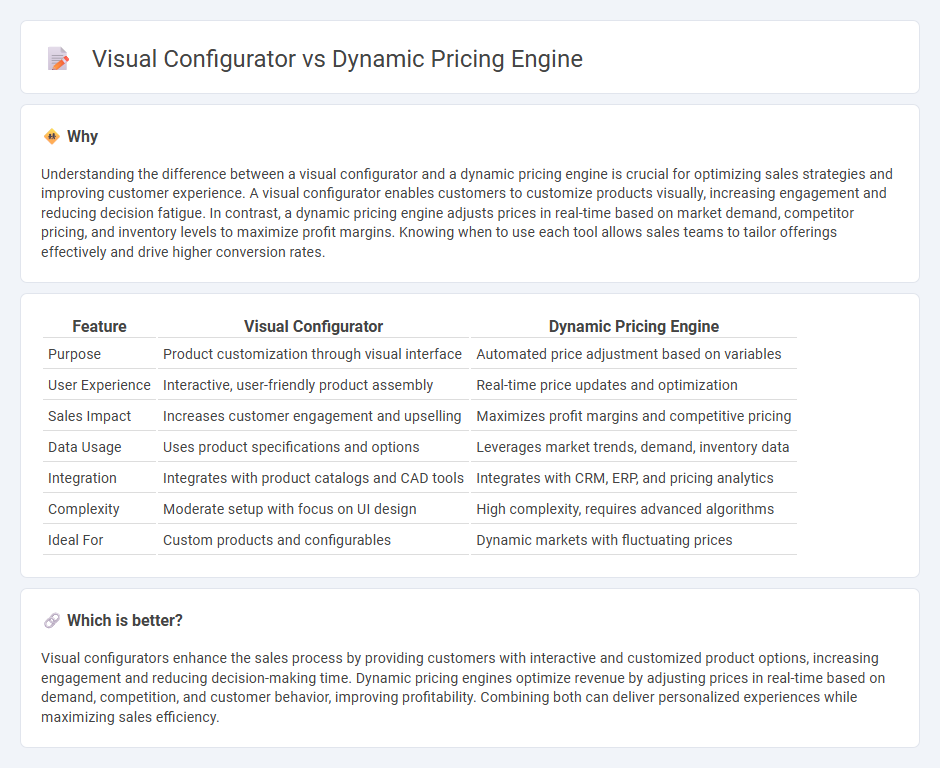
Visual configurators enhance the sales process by allowing customers to customize products interactively, increasing engagement and reducing order errors. Dynamic pricing engines optimize revenue by adjusting prices in real-time based on market demand, inventory levels, and competitor activity. Explore how integrating these technologies can transform your sales strategy and boost profitability.
Why it is important
Understanding the difference between a visual configurator and a dynamic pricing engine is crucial for optimizing sales strategies and improving customer experience. A visual configurator enables customers to customize products visually, increasing engagement and reducing decision fatigue. In contrast, a dynamic pricing engine adjusts prices in real-time based on market demand, competitor pricing, and inventory levels to maximize profit margins. Knowing when to use each tool allows sales teams to tailor offerings effectively and drive higher conversion rates.
Comparison Table
| Feature | Visual Configurator | Dynamic Pricing Engine |
|---|---|---|
| Purpose | Product customization through visual interface | Automated price adjustment based on variables |
| User Experience | Interactive, user-friendly product assembly | Real-time price updates and optimization |
| Sales Impact | Increases customer engagement and upselling | Maximizes profit margins and competitive pricing |
| Data Usage | Uses product specifications and options | Leverages market trends, demand, inventory data |
| Integration | Integrates with product catalogs and CAD tools | Integrates with CRM, ERP, and pricing analytics |
| Complexity | Moderate setup with focus on UI design | High complexity, requires advanced algorithms |
| Ideal For | Custom products and configurables | Dynamic markets with fluctuating prices |
Which is better?
Visual configurators enhance the sales process by providing customers with interactive and customized product options, increasing engagement and reducing decision-making time. Dynamic pricing engines optimize revenue by adjusting prices in real-time based on demand, competition, and customer behavior, improving profitability. Combining both can deliver personalized experiences while maximizing sales efficiency.
Connection
Visual configurators empower customers to customize products in real-time, generating precise specifications that feed directly into dynamic pricing engines. Dynamic pricing engines analyze these custom configurations alongside market demand, inventory levels, and competitor pricing to instantly calculate optimal prices. This seamless integration enhances sales efficiency by delivering tailored pricing that reflects personalized product options and current market conditions.
Key Terms
Dynamic Pricing Engine:
A dynamic pricing engine uses real-time data and machine learning algorithms to adjust product prices based on market demand, competition, and inventory levels, maximizing revenue and profitability. It integrates with sales platforms and CRM systems to deliver personalized pricing strategies that respond instantly to changing consumer behavior and external factors. Discover how dynamic pricing engines can transform your pricing strategy and boost business performance.
Real-time price optimization
Dynamic pricing engines leverage algorithms and real-time market data to optimize prices instantly, maximizing revenue based on supply, demand, and competitor pricing. Visual configurators enhance customer experience by allowing real-time product customization but lack direct price optimization capabilities. Explore how integrating both tools can drive sales and profitability in dynamic markets.
Algorithmic pricing
Algorithmic pricing in dynamic pricing engines uses advanced machine learning models and real-time data analysis to optimize prices based on market demand, competitor behavior, and customer profiles, enabling precise revenue management. Visual configurators primarily focus on product customization experiences, lacking sophisticated pricing algorithms and real-time market responsiveness. Explore detailed comparisons to understand how algorithmic pricing can transform your sales strategy.
Source and External Links
Dynamic Pricing Algorithms in 2025: Top 3 Models - This article discusses how dynamic pricing algorithms work, including models like Bayesian, reinforcement learning, and decision trees, to optimize pricing based on demand and market conditions.
Dynamic Pricing Rule Engine - This article explores the use of dynamic pricing rule engines to automate pricing adjustments based on real-time market conditions, improving efficiency and accuracy.
Dynamic Pricing Software - Prisync's dynamic pricing software automatically adjusts prices to stay competitive with market changes and improve profit margins, supported by a 14-day free trial.
 dowidth.com
dowidth.com